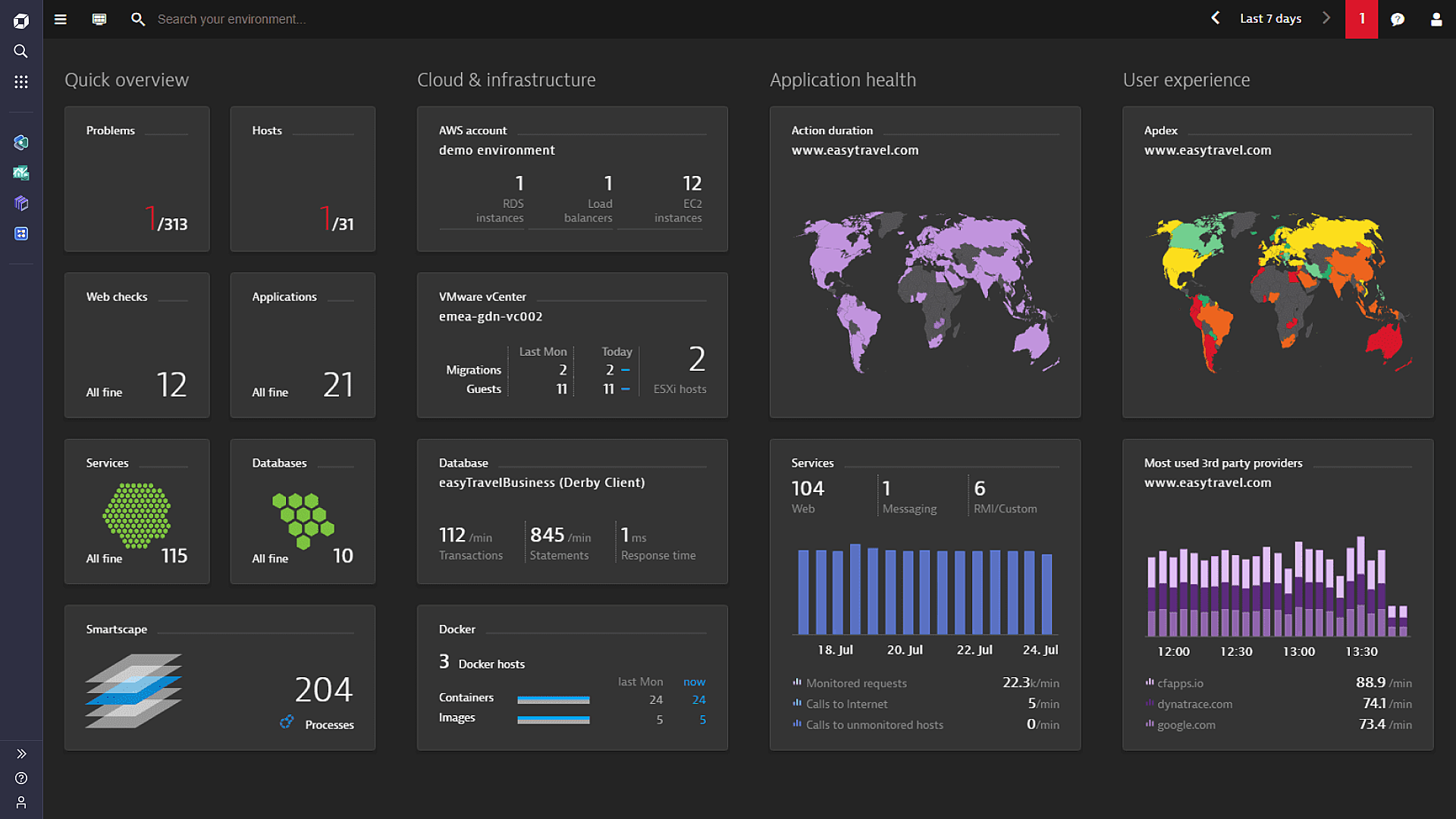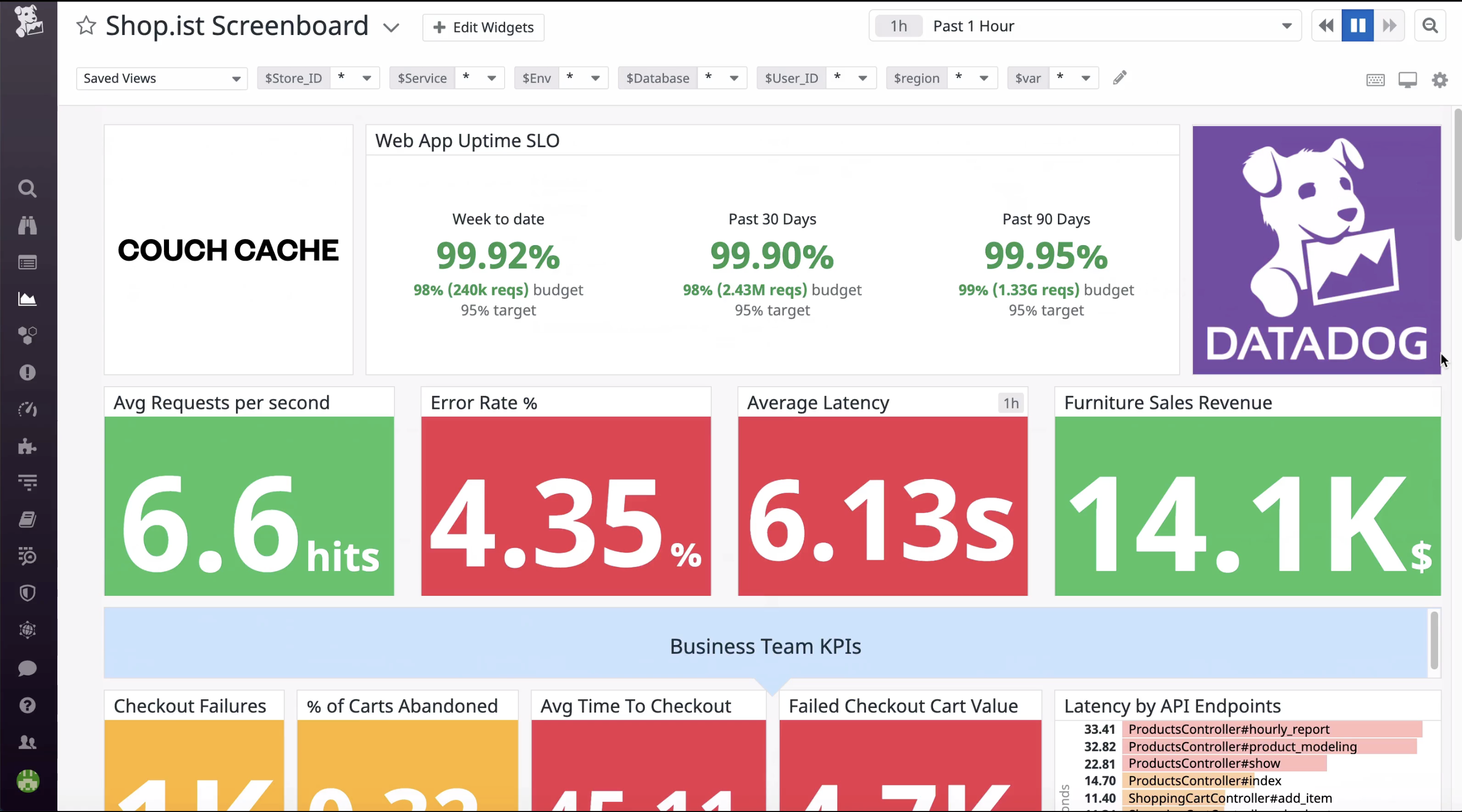In the fast-paced world of digital transformation, ensuring the seamless operation and performance of software applications is not just a priority - it's a necessity. Application performance monitoring (APM) stands at the forefront of this endeavor, providing businesses and their technical teams with the insights and tools needed to maintain, optimize, and enhance the digital experience.
This article dives into the essence of APM, highlighting its purpose, significance, and the real business benefits it brings along. Discover key APM metrics and a guide to what to pay attention to.
What is Application Performance Monitoring?
Application performance monitoring (AMP) is a comprehensive approach that collects, tracks, and analyzes performance metrics from software applications to ensure they run efficiently. This methodology encompasses real user monitoring, application performance infrastructure monitoring, and end user experience monitoring. By leveraging APM, organizations can preemptively detect and address performance issues, ensuring their digital services meet user demand and service level agreements (SLAs).
Why is Application Performance Monitoring important?
The digital experience has become a critical component of business success. Application downtime or performance degradation not only affects internal operations but also damages customer satisfaction and trust. APM solutions are crucial in identifying bottlenecks, memory usage anomalies, CPU utilization spikes, and other performance problems that could impact critical business applications. Moreover, APM's role in synthetic monitoring and user defined transaction profiling allows businesses to simulate and test applications in various scenarios before they impact real users.
How can performance metrics contribute to your business benefits?
Implementing an effective application performance monitoring solution translates into several business advantages:
- Enhanced user experience
APM platforms ensure applications are responsive and available, contributing to a flawless user experience. - Proactive problem resolution
Businesses can maintain application availability and performance by identifying issues before they affect users. - Optimized performance
Insights into application component behavior and performance allow for fine-tuning and optimization, leading to efficient resource use and cost savings. - Business continuity
APM supports business continuity by monitoring application health and performance, ensuring that operations run smoothly. - Data-driven decisions
The telemetry data collected provides actionable insights into user behavior, application performance, and infrastructure needs, guiding strategic decisions.
Check how else monitoring services can support your business.
Key metrics for Application Performance Monitoring
Application performance monitoring relies on many metrics to assess applications' health and efficiency. These metrics are critical for understanding how applications perform in real time, identifying areas for improvement, and ensuring a seamless user experience. Among the multiple performance metrics, certain key indicators stand out for their direct impact on application usability and performance:
Response time
Measures the time taken for an application to respond to a user's request. It's crucial for assessing user experience, as longer response times can lead to frustration and disengagement.
Error rate
Tracks the number of errors within an application compared to the total number of requests. High error rates can indicate underlying performance issues or software bugs that need immediate attention.
CPU utilization
Reflects the percentage of CPU resources being used by the application. Monitoring CPU utilization helps in identifying performance problems related to inefficient code or resource-intensive operations.
Memory usage
Indicates the amount of memory consumed by the application. It's vital for detecting memory leaks or other memory-related performance issues that could degrade application performance over time.
Throughput
Measures the number of transactions or requests an application can handle over a given period. It provides insights into the application's capacity to meet user demand and maintain performance under load.
Apdex score (Application Performance Index)
The Apdex score is a standardized way to report on just about any user experience by converting many measurements into a single simple to understand zero-to-one score. It offers a simplified view of application performance by classifying user experiences into three categories: satisfied, tolerating, and frustrated. These categories reflect values between 0 and 1. This score helps quantify user satisfaction and set performance targets that are aligned with business objectives.
Availability
Tracks the percentage of time an application is available for use, excluding maintenance periods. High availability is critical for business critical applications, ensuring that users can access the services they need without interruption.
Monitoring these metrics provides a comprehensive overview of an application's performance, offering actionable insights to address performance issues, optimize resource usage, and ultimately enhance the digital experience for users. APM solutions leverage these metrics to help organizations monitor availability, assess applications' health, and ensure that software applications perform optimally in complex application environments.
APM Platforms vs. APM Tools
The terms APM platforms and APM tools are often used interchangeably, but they represent different scopes within the APM spectrum. An APM platform is a comprehensive solution that integrates various monitoring capabilities (e.g. real user monitoring, synthetic monitoring, database monitoring) into a unified system. It provides a holistic view of the entire application stack, from frontend to backend, including infrastructure and network components. APM platforms often integrate with other tools to use, for example, their metrics.
On the other hand, APM tools might focus on specific aspects of application monitoring, such as server monitoring, error tracking, or user experience monitoring. These tools can be part of an APM platform or used independently, depending on the organization's needs.
APM platforms overview
APM platforms provide an all-encompassing approach to monitoring and managing the performance of software applications across complex application environments. Unlike individual APM tools, which may target specific aspects of performance monitoring, APM platforms offer a holistic view of an application's health, performance, and user experience. They integrate various monitoring functionalities, including but not limited to real user monitoring, synthetic monitoring, database monitoring, and application performance infrastructure monitoring. This integration facilitates a deeper understanding of an application's performance, from the user interface to the network and infrastructure levels.
Dynatrance

Dynatrace is a leader in the APM platform space, known for its cutting-edge artificial intelligence for IT operations (AIOps) capabilities. It provides automated, full-stack monitoring from the application layer to the database, infrastructure, and cloud services.
New Relic One

New Relic One offers a powerful observability platform with real-time analytics and full-stack visibility into the performance of web and mobile applications.
Datadog

Datadog provides a cloud-based platform that is highly scalable and integrates seamlessly with a wide range of cloud services, containers, and serverless architectures.
AppDynamics

Owned by Cisco, AppDynamics delivers a comprehensive inventory of agents by Smart Agent, efficiently identifying and updating outdated agents for improved version compliance and reporting, offering real-time insights into application performance, user experiences, and business outcomes.
Splunk APM

Splunk APM is designed for real-time performance monitoring and troubleshooting, offering powerful analytics, and is particularly well-suited for investigating and understanding complex performance issues.
APM platforms provide a comprehensive solution for monitoring the performance of applications across diverse and complex environments. They offer deep insights into every aspect of application performance, enabling organizations to detect and resolve issues proactively, improve user experiences, and align IT performance with business objectives. The choice among these platforms should be guided by the specific needs of the organization, including the scale of operations, the complexity of the application environment, and the level of expertise available to manage and interpret the data.
Key steps before integrating APM with your organization
The process of integrating application performance monitoring requires careful planning and consideration to ensure that the chosen APM solution aligns with your organizational needs and technical infrastructure. Before embarking on the integration of APM platforms, it's essential to undertake several preparatory steps and address pivotal questions to lay a solid foundation for successful monitoring.
Assess your application environment
Understand the complexity of your application environments, including the types of applications (web applications, mobile devices) and the infrastructure components (servers, databases, network components) involved. This assessment helps in selecting an APM tool that can handle the specificities of your environment.
Define your monitoring objectives
Clearly articulate what you aim to achieve with APM. Are you focusing on improving response times, ensuring application availability, or monitoring the digital experience of your users? Setting clear objectives guides your choice of APM platforms and the features you prioritize.
Evaluate integration capabilities
Investigate how well potential APM platforms integrate with your existing technology stack. Compatibility with your operating systems, databases, and other software components is crucial for seamless performance monitoring.
Consider scalability
As your business grows, so will your monitoring needs. Ask how scalable the APM solution is in terms of handling increased data volumes, more complex application architectures, and higher user demand.
Inquire about customization and flexibility
Determine the extent to which the APM platform allows for customization and flexibility in monitoring. Can you define custom metrics or set up user-defined transaction profiling to suit your unique business transactions?
Analyze cost implications
Understand the pricing model of the APM solution and how it scales. Consider the total cost of ownership, including any additional costs for advanced features or increased usage.
Review security measures
Since APM platforms collect and analyze sensitive telemetry data, assess the security measures in place to protect this data. Ensure compliance with industry standards and regulations to safeguard your IT environment.
Plan for training and support
Finally, consider the level of training and support provided by the service provider. A tool with comprehensive documentation, responsive customer service, and resources for training can significantly ease the integration process.
Advanced analytics for modern application architectures
Effective application performance monitoring is crucial for maintaining the health and efficiency of modern applications. It not only ensures application availability and performance but also plays a significant role in delivering a superior user experience. While APM platforms offer a comprehensive overview of an application's performance, APM tools provide targeted insights into specific areas. The choice between an APM platform and APM tools depends on the specific needs, size, and complexity of your application environment.







